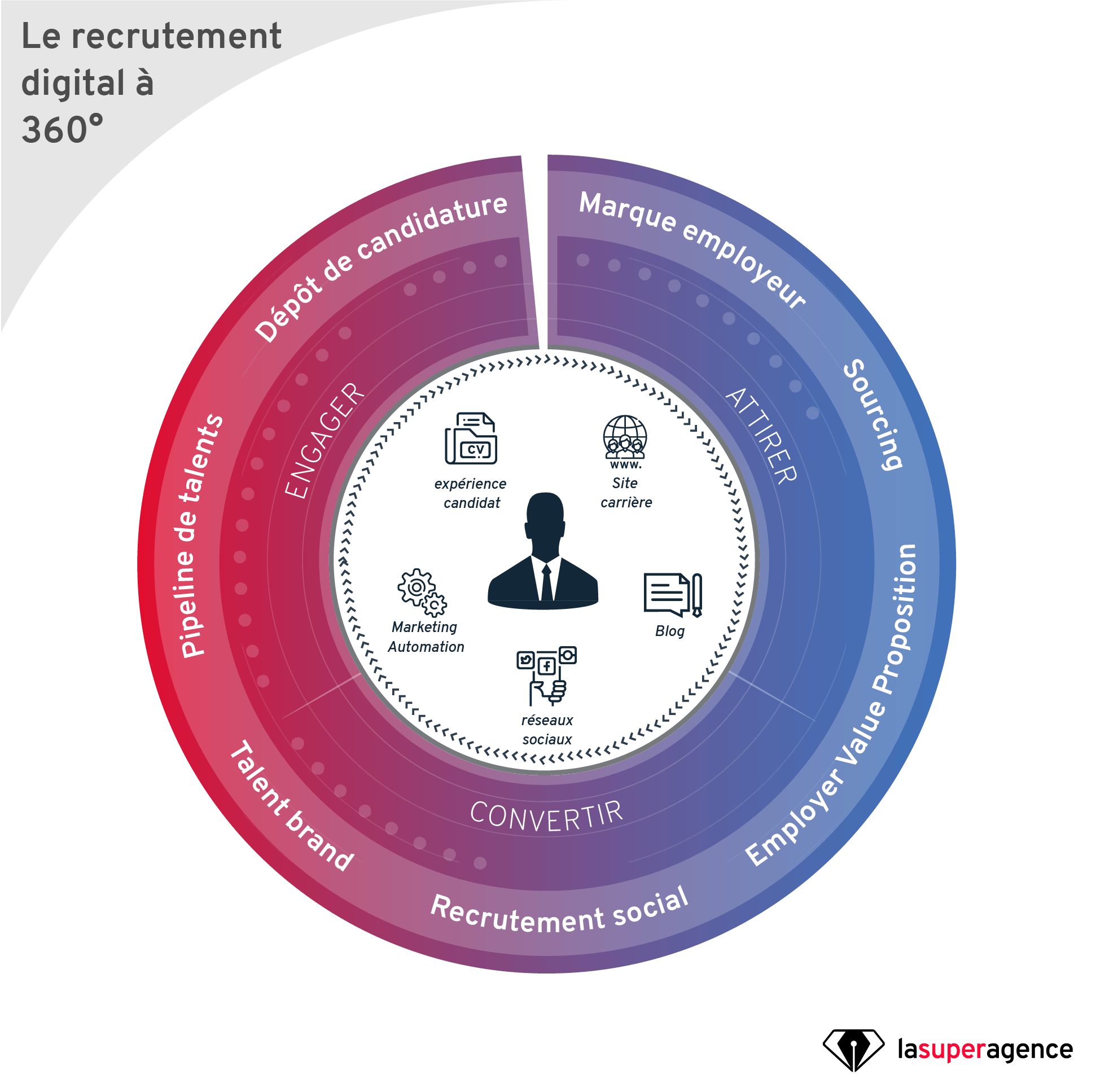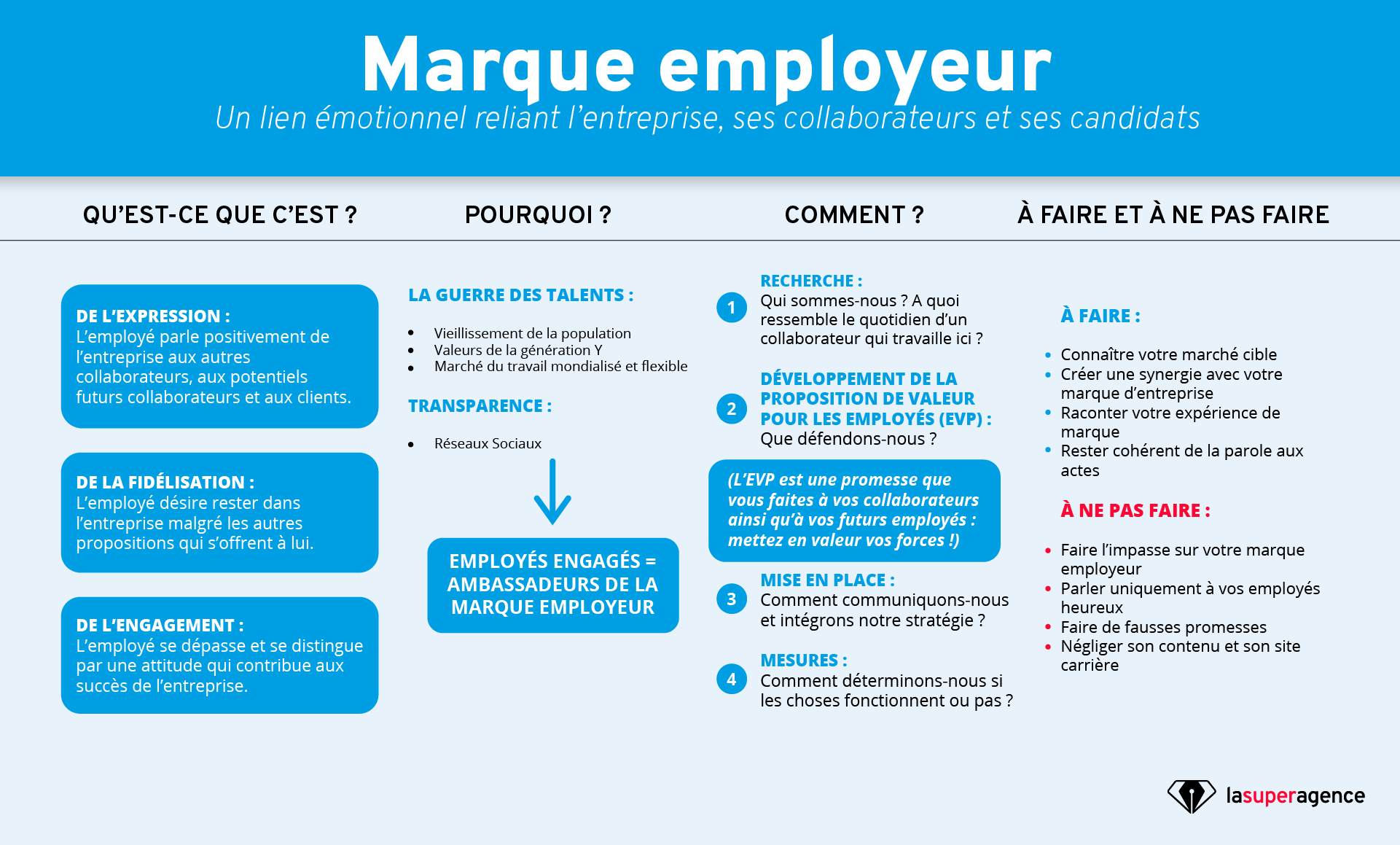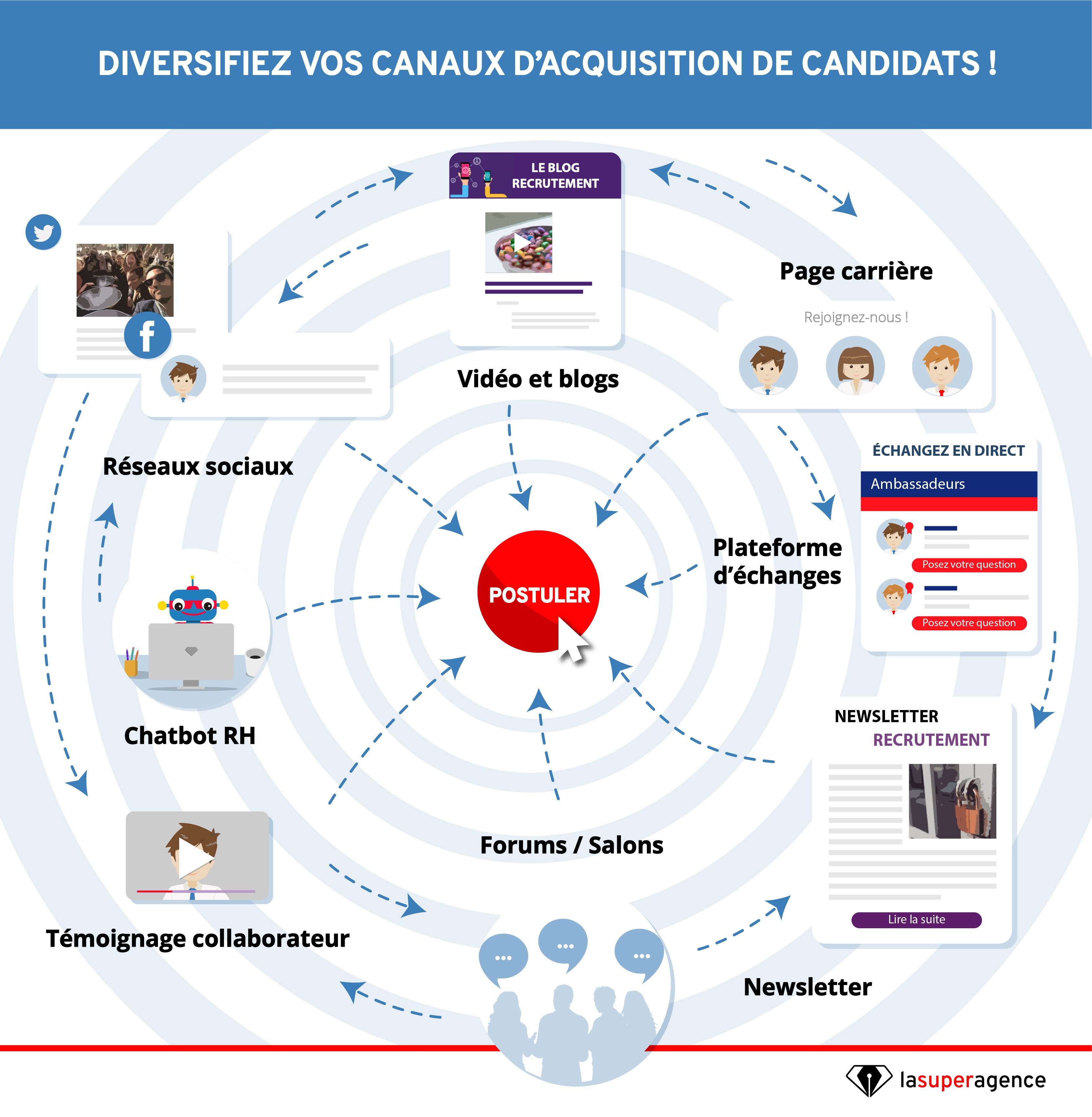Since the beginning of the 2010s, recruitment marketing (especially its digital component) has tended to impose itself in the dual context of the digital transformation of companies and the scarcity of certain talents in the job market.
It becomes, from a strategic point of view, essential to build and communicate on your employer brand to be able to exist with candidates.
One of the main goals of Recruitment Marketing isto attract and hire top talent.
What is Recruitment Marketing?
Recruitment Marketing is a process of attracting and nurturing (content) talented people in your (mostly digital) spaces and then converting them into candidates using Marketing methods and tactics.
This is now a must-have recruitment strategy.
The 4 main objectives of a Recruitment Marketing strategy are:
- Promote your company to potential candidates and open positions .
- Spark their interest in your company
- Getting them to consider you as their next employer of choice and
- Incite talent to apply for open positions at your company.
By highlighting your employer brand, Recruitment Marketing attracts self-selecting candidates to your application process.
It helps sources, recruiters and talent acquisition specialists reduce the time and money spent on unqualified candidates.
Which platform to use for Recruitment Marketing?
Recruitment Marketing can be simplified through the use of platforms like Hubspot that allow you to build long-lasting, nurturing relationships with potential candidates.
Using Recruitment Marketing platforms, recruiters can create different campaigns to target people within specific talent pools and share specific messages with candidates.
Recruiters can also save time by scheduling automated emails that allow candidates to see current job applications relevant to them.
Every Recruitment Marketing platform also has a career site template on which anyone can create an engaging site that reflects company cultures and values and provides content to that effect.
All of the solutions offered by HubSpot as long as you are well accompanied!
Where does Recruitment Marketing come from?
The Recruitment Marketing strategy was born out of a new situation in the human resources industry.
As the demand for talent has far outstripped its supply in some key areas, this has led to a "war for talent" or more accurately "a war for attention." As a result, the way we recruit has radically changed.
Today, talented candidates have many professional offer options to choose from. The use of search engines such as Google makes it essential to have content that is relevant to candidates but more importantly, optimized through SEO techniques.
It is in this context that job advertising and candidate search have become very similar to product advertising and customer search.
The candidate journey has shifted from the application, selection, and hiring stage to a schema encompassing a much vaster number of elements such as the Employer Brand, Candidate Experience, Social Recruiting, etc.

Effective recruiters, using Marketing tactics, know how to "sell" themselves as employers and engage candidates from the earliest stages of their candidate journey .
The Elements of Recruitment Marketing
- Employer Branding:
Your employer brand is the reflection of your culture, values and mission. The content you present on your employer brand should be authentic, relevant and compelling.
The employer brand must be constantly worked towards potential candidates via the various channels or contact points.

Here are some keys to improving your employer brand.
- Inbound Recruiting:
Inbound Recruiting or inbound recruitment is a method in which companies, through useful and informative content, attract and engage talent. Some forms of content may include the company's career blog, team blogs on interesting projects and many others.
Here are some tips on how to create an interesting career blog for your candidates.
- The employee value proposition:
A Employee Value Proposition is the reward or benefit an employee can expect to receive in exchange for performance. A value proposition is your sales pitch, it's what distinguishes you, makes you unique and authentic to candidates.
- The creation of a Candidate Persona:
Candidate personas are a profile of the desired skills, experiences, and cultural fit of the candidates you want to target and attract.
They should include an analysis of the target candidates' career issues, motivations and goals, as well as the social channels and platforms on which they are likely to be found.
The creation of the Candidate Persona must be based on tangible data to be as close to reality as possible. For each position, a fictional representation of the ideal candidate is then established.
This article will walk you through the steps to define a Candidate Persona.
- Competitor Analysis:
To attract the best candidates, you need to know what your competitors are doing.
This type of information helps you understand which strategies are just table stakes and where you may be able to carve out a clear competitive advantage.
- The candidate experience:
Finding the right candidates is not easy. Once you've managed to do that, it's important to keep them happy. Providing an exceptional candidate experience throughout the recruitment, screening and hiring process is a must!
Candidate experience has a huge impact on your employer brand.
Negative words spread quickly, so try to avoid negative comments and bad reviews.
Don't forget the importance of being mobile-friendly: 45% of candidates want to be able to search and apply for jobs on their phones.
- Recruiting based on HR data or analytics:
Like Marketing, HR has become data-driven. Every step of the recruitment process can be tracked and measured. Successful recruiters, track this data to be able to make better and more informed decisions.
The tracking of items such as website visitors, candidates, candidate source, newsletter and event conversion rates, hire rates by source, qualified candidates by source, the performance of employee-referral-programs, time, cost, and quality of hire can give you important information about your recruiting strategy.
You can then see what is working and what needs to be improved.
Don't know how to measure them? Here are some Recruitment Marketing KPIs (tracking indicators).
Recruitment Marketing Metrics
The success of Recruitment Marketing can be measured with metrics similar to recruitment itself. A successful Recruitment Marketing campaign will reduce your recruiting costs and your hiring time, as it will a draw more qualified and committed candidates to your open position.
- Cost per applicant:
Your Recruitment Marketing spend divided by the number of applicants
- Cost per hire:
Your recruitment marketing spend divided by the number of hires
- Visitor to applicant ratio:
The number of candidates divided by the number of visitors to your website
Example: The industry average conversion rate from website visitors to candidates is 11%
- Application to Hire Ratio:
Applicant-to-interviewee ratio: the number of applicants divided by the number of interviewees
Example: The industry average conversion rate from candidates to interviewees is 12%
Interviewee to offer ratio: the number of offers divided by the number of interviewees
Example: The average conversion rate of respondents to offers is 17%
Offer-to-hire ratio: the number of hires divided by the number of offers
Example: The industry average conversion rate from offers to hires is 89%
- Hiring deadline:
The average time to hire in industry is 41 days
The average length of presence of top performers in the labor market is 10 days
What are the strategies of Recruitment Marketing?
Whatever method you communicate, you should always convey in a authentic manner your company's culture and mission, as well as the benefits and perks of the position.
- The Content Marketing
This is the first building block of a broader Inbound Marketing approach.
It posits on the front end the ability to attract visitors with interesting content and on the back end to turn those visitors into qualified leads.
This article will show you the importance of getting interested in Content Marketing.
- Job opportunities
It is critical to pay close attention to referencing ( SEO) key words for the job title you are hiring for.
When posting jobs, you need to be careful to target your Candidate Persona.
The job posting will need to be mobile friendly and show photos and videos to attract candidates.
- The career site:
To do lead generation on your career site, you can adapt Marketing methods to your recruitment strategy.
This can be traditional "Outbound" advertising solutions, such as paid search, or you can apply the Inbound Recruiting strategy.
Don't forget to optimize your career site with photos and videos and make sure it's mobile friendly so it can drive candidates to apply via as many channels as possible.

- Email nurturing:
The goal is to send progressive emails to move prospects from the awareness stage, to consideration and then conversion. This way, your contacts in the "interest stage" will be redirected to a program that encourages them to convert.
A good nurturing policy should be:
- Timing: You have to get the timing right with Automation Marketing
- Effective: To maximize talent productivity
- Targeted: It's critical to know your employees well
Test multiple channels and multiple mediums at all times to gather information and ensure your messages are relevant.
- Social media feeds:
According to Glassdoor, 79% of job seekers use social media during their job search.
It is therefore important to be able to attract candidates on social networks such as Facebook and Twitter by, for example, creating unique hashtags for job openings or adding visuals of your company.
- Employee Referral Programs:
You shouldn't skip out on training your employees about your employer brand and your recruitment plan.
Turning your employees into ambassadors for your brand fosters their engagement with your company.
- Talent Communities:
Every company must be able to create a talent community grouping:
- Candidates who are interested in your company but whose skills and experience are not currently a good fit
- Candidates who did not get the job they originally applied for and are interested in future opportunities
You also need to maintain a pipeline of qualified and engaged candidates.
To do this, you can invite them to subscribe to your blog or newsletter, follow your social media accounts and participate in special offers and contests
What to r from Recruitment Marketing
Recruitment Marketing was introduced because of the current (non-Covid-19) situation in the labor market.
Thus, employers must work harder to find and attract high-quality, qualified candidates.
His main objective is to follow the latest market trends and provide solutions for companies to best overcome these new challenges.
Make sure you are practicing the fundamentals of Recruitment Marketing by communicating your employer brand through workplace photos on your social media accounts, explaining your company culture in job postings, and targeting your ideal candidates where they are most likely to be found such as specialized job boards or talent markets.
Companies that adopt these new recruiting best practices first will be more likely to attract talent.







